Analysis of Laravel5 quick authentication logic flow
This article mainly introduces the analysis of Laravel5's fast authentication logic process. It has certain reference value. Now I share it with you. Friends in need can refer to it.
Laravel5 itself comes with a set of user authentication function, just use the command line php artisan make:auth and php artisan migrate under the new project to use the built-in fast authentication function.
The following is a logical analysis of the login function, which is based on Laravel 5.5 version.
Get the login route (red box) through the command php artisan route:list:

Open and view /app/Http/Controller/Auth/LoginController.php , the file code is very concise. In fact, the login logic and methods are integrated in the trait of Illuminate/Foundation/Auth/AuthenticatesUsers:
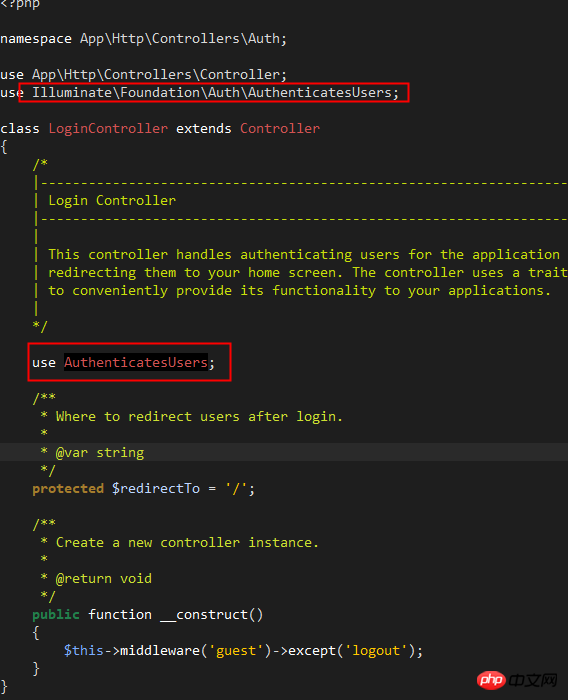
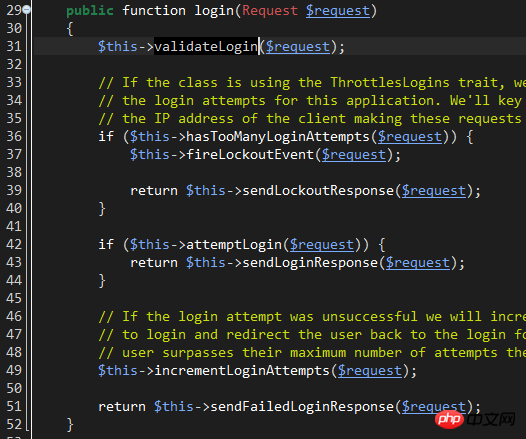
line31: The validateLogin method is responsible for calling The validate method of the controller itself verifies whether the username and password comply with simple rules. There is no need to go into this in depth.

line36: hasTooManyLoginAttempts method, used to check whether the number of account login attempts reaches the set maximum value.
This method refers to the trait of Illuminate\Foundation\Auth\ThrottlesLogins. Looking at the trait name, you can guess that it is responsible for avoiding violent logins.
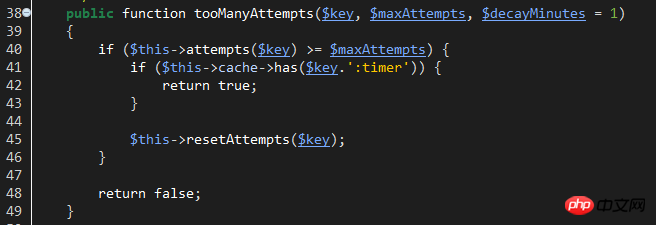
$key: The corresponding key used by cacche to save the login number of the current account. The key composition is like this:

$maxAttempts: Setting value for the maximum number of login attempts.
This value can be customized. You can write the custom maxAttempts attribute in LoginController. The default is 5 times:
$decayMinutes:The waiting time (minutes) for resuming login after reaching the maximum number of attempts.
This value is also customizable. Customize this property in LoginController. The default is 1 minute:


When hasTooManyLoginAttempts returns true, the Lockout event is initiated and the LockoutResponse response is returned. Users can generate a Lockout event monitor to process the logic related to the event, such as recording login logs, etc.
LockoutResponse response essentially throws a verification exception, which will be automatically interpreted by Laravel as a response with a 423 status code and accompanied by auth.throttle configuration information. The original language of this configuration is located at: /resources/lang/en/auth.php. Users can customize their own language information.
Then, return to line 42 of Illuminate\Foundation\Auth\AuthenticatesUsers and start to perform login verification:

attemptLogin method passes config/auth.php Configure the guard name, generate the corresponding guard object, and then call the object's attempt for login verification.

Laravel5 guard currently supports two types: SessionGuard and tokenGuard, both are saved in the Illuminate\Auth folder, and they are both implemented in the Illuminate\Contracts\Auth\Guard interface. So if you need to customize the watcher, please implement this interface.
If you want to implement a web guard, you can further implement the Illuminate\Contracts\Auth\StatefulGuard interface.
As for which guard to use under which circumstances, they are all configured in config/auth.php:
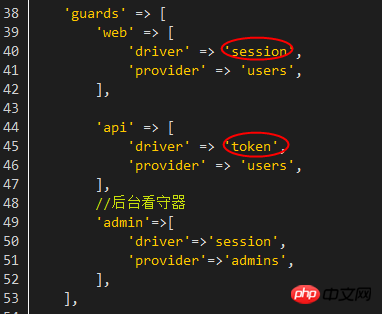
Since what I analyzed this time is Web login process, so check the attempt method of Illuminate\Auth\sessionGuard:
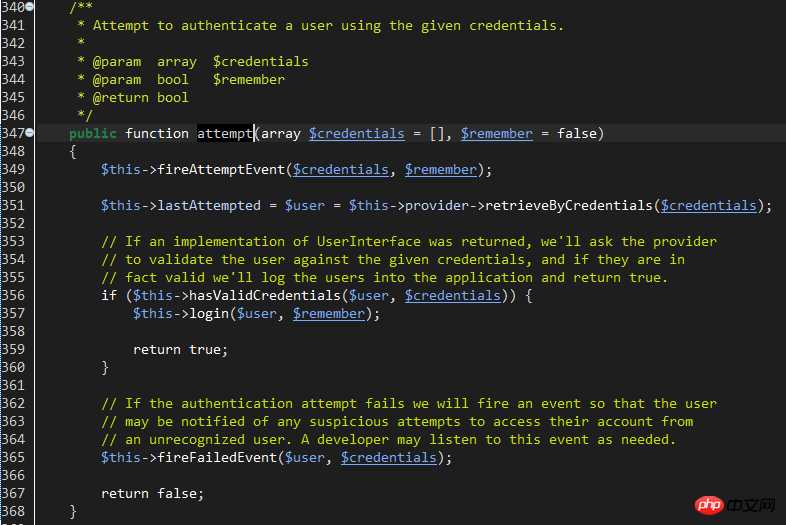
#line 351: The function of this line is to retrieve the account information through the configured provider provider. There are also two types of providers: DatabaseUserProvider and EloquentUserProvider. The file is located at: /Illuminate/Auth.
The specific provider to use is configured through the providers parameter of config/auth.php. After configuration, you also need to specify which provider to use in the 'guards' parameter. The provider essentially provides a way to query the database account table. Database directly uses the database Db facade to query, while eloquent uses a model to query.
Laravel uses EloquentUserProvider by default. Looking at the retrieveByCredentials method, it is obvious that the user information is retrieved directly by the account name:
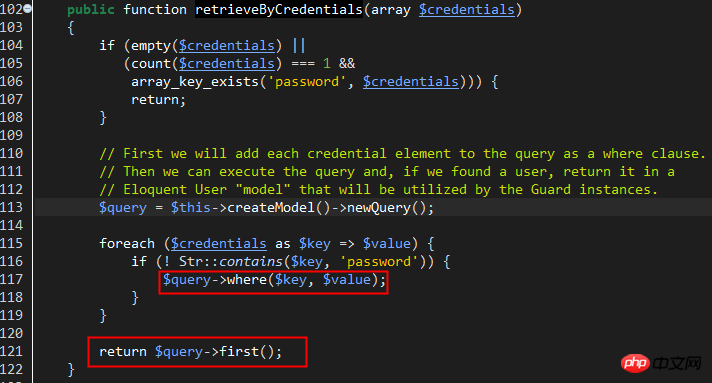
Back The attempt method of Illuminate\Auth\sessionGuard and the hasValidCredentials method of line 356 verify the password, if the user information in the previous step can be retrieved normally.
As can be seen from the hasValidCredentials method body, it calls the provider's validateCredentials method for password verification. Check out the EloquentUserProvider::validateCredentials method:

This verification method uses the check method of the hash class implemented by the HasherContract contract. The specific implementation classes are: Illuminate\Hashing\BcryptHasher. Let's look at the check method of this class:

Obviously, it uses the password_verify function to compare the entered plaintext password with the hashed password value. This requires that the database passwords have been hashed using password_hash.
If the password verification is successful, return true. Return to sessionGuard and execute the login method of line357 to record the session and cookie login status.
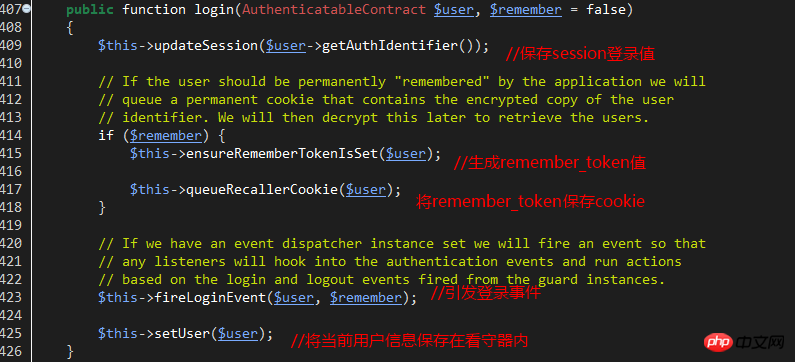
The key and value of the saved session are:
'key'=>'login_session_'.sha1(static::class) // static::class refers to the sessionGuard class itself
'value'=>The primary key value of the current user
If the remember_me option is used, the following cookie is saved, and the key and value are as follows:
'key'=>''remember_session_'.sha1(static::class) //static::class refers to the sessionGuard class itself
'value'=>User primary key value .'|'.The latest remembered_token value saved.'|'.User password hash value
At this point, the user has successfully logged in, and the execution point finally returns to line 42 of Illuminate\Foundation\Auth\AuthenticatesUsers , attemptLogin has been executed and returned true, and then the sendLoginResponse method is called to jump to the main page after login or the last login page.
Note that the authenticated method is an empty method. You can redefine this method in LoginController to customize how to jump and process other logic after login.
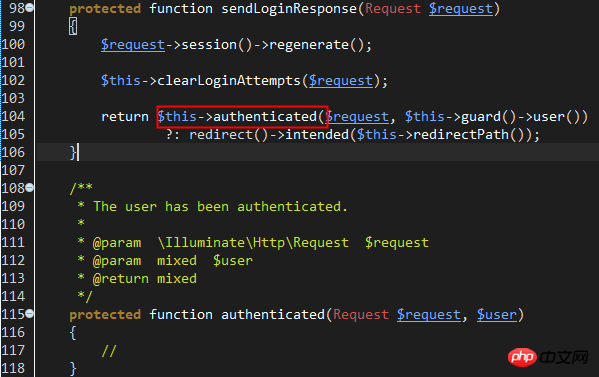
If the login is unsuccessful, execute the incrementLoginAttempts($request) method of Illuminate\Foundation\Auth\AuthenticatesUsers to increase the number of failed logins. The method to increase the number of times is also to indirectly call the hit() method of the RateLimiter class.
Finally call sendFailedLoginResponse to return a login exception.
Finally, the timing diagram is attached. The drawing is average. Some UML concepts are not well grasped. Sorry:
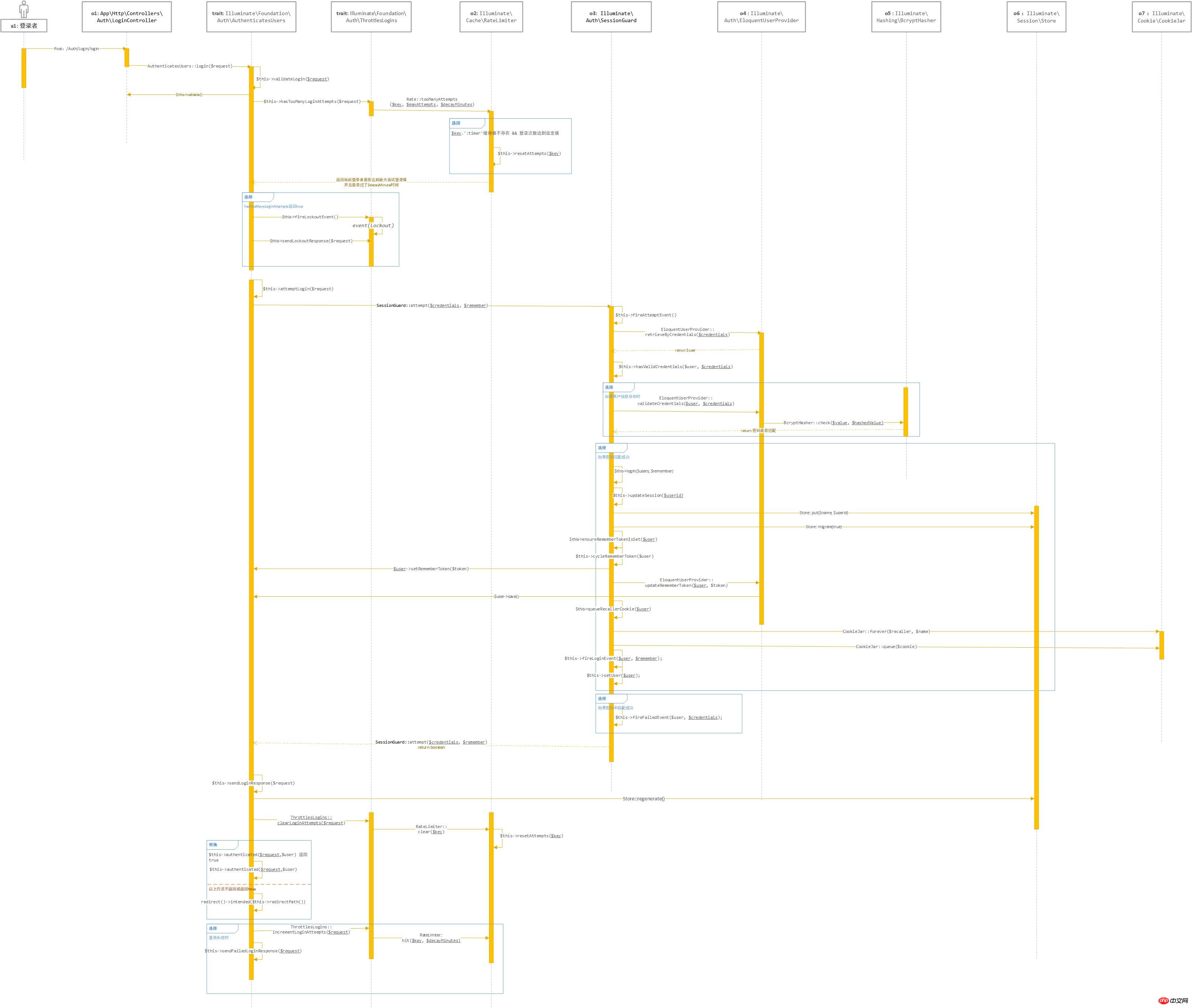
That’s all. The entire content of this article is hoped to be helpful to everyone's study. For more related content, please pay attention to the PHP Chinese website!
Related recommendations:
Introduction to Laravel’s Eloquent model
How to use Wamp to build a Php local development environment and HBuilder debugging
The above is the detailed content of Analysis of Laravel5 quick authentication logic flow. For more information, please follow other related articles on the PHP Chinese website!

Hot AI Tools

Undresser.AI Undress
AI-powered app for creating realistic nude photos

AI Clothes Remover
Online AI tool for removing clothes from photos.

Undress AI Tool
Undress images for free

Clothoff.io
AI clothes remover

Video Face Swap
Swap faces in any video effortlessly with our completely free AI face swap tool!

Hot Article

Hot Tools

Notepad++7.3.1
Easy-to-use and free code editor

SublimeText3 Chinese version
Chinese version, very easy to use

Zend Studio 13.0.1
Powerful PHP integrated development environment

Dreamweaver CS6
Visual web development tools

SublimeText3 Mac version
God-level code editing software (SublimeText3)

Hot Topics
 1677
1677
 14
14
 1430
1430
 52
52
 1333
1333
 25
25
 1278
1278
 29
29
 1257
1257
 24
24
 Explain secure password hashing in PHP (e.g., password_hash, password_verify). Why not use MD5 or SHA1?
Apr 17, 2025 am 12:06 AM
Explain secure password hashing in PHP (e.g., password_hash, password_verify). Why not use MD5 or SHA1?
Apr 17, 2025 am 12:06 AM
In PHP, password_hash and password_verify functions should be used to implement secure password hashing, and MD5 or SHA1 should not be used. 1) password_hash generates a hash containing salt values to enhance security. 2) Password_verify verify password and ensure security by comparing hash values. 3) MD5 and SHA1 are vulnerable and lack salt values, and are not suitable for modern password security.
 How does PHP type hinting work, including scalar types, return types, union types, and nullable types?
Apr 17, 2025 am 12:25 AM
How does PHP type hinting work, including scalar types, return types, union types, and nullable types?
Apr 17, 2025 am 12:25 AM
PHP type prompts to improve code quality and readability. 1) Scalar type tips: Since PHP7.0, basic data types are allowed to be specified in function parameters, such as int, float, etc. 2) Return type prompt: Ensure the consistency of the function return value type. 3) Union type prompt: Since PHP8.0, multiple types are allowed to be specified in function parameters or return values. 4) Nullable type prompt: Allows to include null values and handle functions that may return null values.
 PHP and Python: Different Paradigms Explained
Apr 18, 2025 am 12:26 AM
PHP and Python: Different Paradigms Explained
Apr 18, 2025 am 12:26 AM
PHP is mainly procedural programming, but also supports object-oriented programming (OOP); Python supports a variety of paradigms, including OOP, functional and procedural programming. PHP is suitable for web development, and Python is suitable for a variety of applications such as data analysis and machine learning.
 Choosing Between PHP and Python: A Guide
Apr 18, 2025 am 12:24 AM
Choosing Between PHP and Python: A Guide
Apr 18, 2025 am 12:24 AM
PHP is suitable for web development and rapid prototyping, and Python is suitable for data science and machine learning. 1.PHP is used for dynamic web development, with simple syntax and suitable for rapid development. 2. Python has concise syntax, is suitable for multiple fields, and has a strong library ecosystem.
 PHP and Python: A Deep Dive into Their History
Apr 18, 2025 am 12:25 AM
PHP and Python: A Deep Dive into Their History
Apr 18, 2025 am 12:25 AM
PHP originated in 1994 and was developed by RasmusLerdorf. It was originally used to track website visitors and gradually evolved into a server-side scripting language and was widely used in web development. Python was developed by Guidovan Rossum in the late 1980s and was first released in 1991. It emphasizes code readability and simplicity, and is suitable for scientific computing, data analysis and other fields.
 Why Use PHP? Advantages and Benefits Explained
Apr 16, 2025 am 12:16 AM
Why Use PHP? Advantages and Benefits Explained
Apr 16, 2025 am 12:16 AM
The core benefits of PHP include ease of learning, strong web development support, rich libraries and frameworks, high performance and scalability, cross-platform compatibility, and cost-effectiveness. 1) Easy to learn and use, suitable for beginners; 2) Good integration with web servers and supports multiple databases; 3) Have powerful frameworks such as Laravel; 4) High performance can be achieved through optimization; 5) Support multiple operating systems; 6) Open source to reduce development costs.
 PHP and Frameworks: Modernizing the Language
Apr 18, 2025 am 12:14 AM
PHP and Frameworks: Modernizing the Language
Apr 18, 2025 am 12:14 AM
PHP remains important in the modernization process because it supports a large number of websites and applications and adapts to development needs through frameworks. 1.PHP7 improves performance and introduces new features. 2. Modern frameworks such as Laravel, Symfony and CodeIgniter simplify development and improve code quality. 3. Performance optimization and best practices further improve application efficiency.
 PHP's Impact: Web Development and Beyond
Apr 18, 2025 am 12:10 AM
PHP's Impact: Web Development and Beyond
Apr 18, 2025 am 12:10 AM
PHPhassignificantlyimpactedwebdevelopmentandextendsbeyondit.1)ItpowersmajorplatformslikeWordPressandexcelsindatabaseinteractions.2)PHP'sadaptabilityallowsittoscaleforlargeapplicationsusingframeworkslikeLaravel.3)Beyondweb,PHPisusedincommand-linescrip




